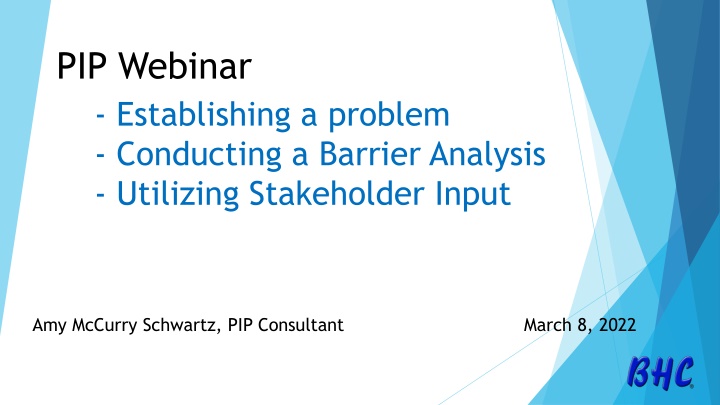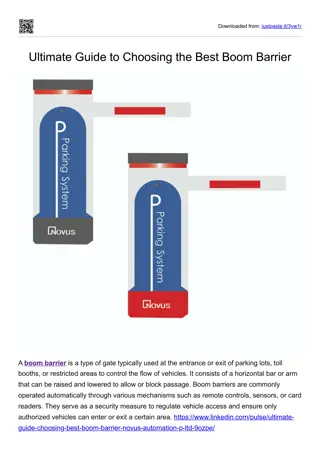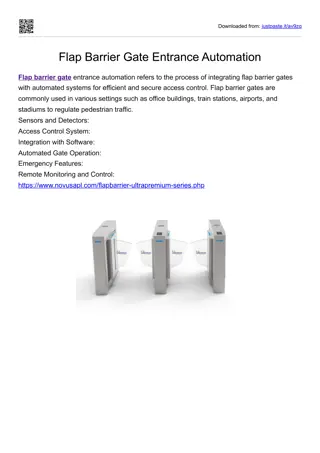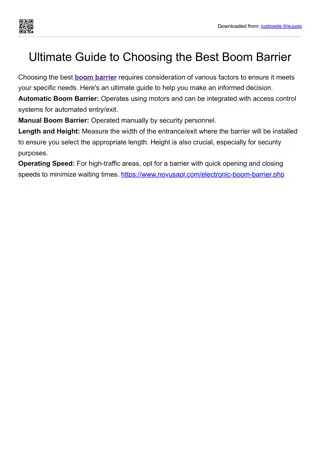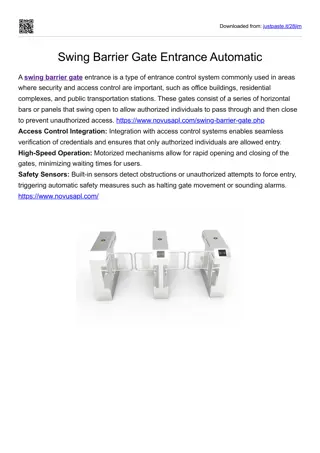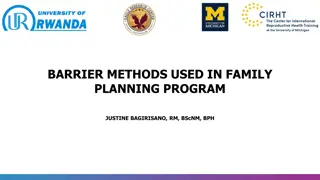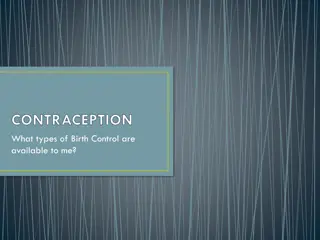Establishing Problem & Conducting Barrier Analysis
This webinar led by Amy McCurry Schwartz, a PIP Consultant, focuses on the crucial process of establishing a problem and conducting a barrier analysis using stakeholder input. Gain valuable insights on effective problem identification and overcoming barriers through stakeholder engagement. Enhance your skills in addressing challenges and driving solutions effectively in your projects and initiatives. Join this session to strengthen your problem-solving approach and achieve greater success in your endeavors.
Download Presentation

Please find below an Image/Link to download the presentation.
The content on the website is provided AS IS for your information and personal use only. It may not be sold, licensed, or shared on other websites without obtaining consent from the author.If you encounter any issues during the download, it is possible that the publisher has removed the file from their server.
You are allowed to download the files provided on this website for personal or commercial use, subject to the condition that they are used lawfully. All files are the property of their respective owners.
The content on the website is provided AS IS for your information and personal use only. It may not be sold, licensed, or shared on other websites without obtaining consent from the author.
E N D
Presentation Transcript
PIP Webinar - Establishing a problem - Conducting a Barrier Analysis - Utilizing Stakeholder Input Amy McCurry Schwartz, PIP Consultant March 8, 2022
Introduction Purpose Discuss ways to define a PIP problem How to use stakeholder input Conduct a barrier analysis Approach Applicable for MHP and DMC-ODS ( BHP )
What is a Performance Improvement Project (PIP)? CMS: A PIP is a project conducted by the BHP that is designed to achieve significant improvement, sustained over time, in health outcomes and enrollee satisfaction. A PIP may be designed to change behavior at a member, provider, and/or BHP/system level. Source: CMS External Quality Review (EQR) Protocols, October 2019, Protocol 1. Validation of Performance Improvement Projects, p. 27.
CMS Steps and PIP Worksheets CMS STEPS 1 9 WORKSHEETS 1 9 Step 1: Identify the PIP Topic Worksheet 1: PIP Topic Step 2: Develop the Aim Statement Worksheet 2: Aim Statement Step 3: Identify the PIP Population Worksheet 3: PIP Study Population Step 4: Describe the Sampling Method Worksheet 4: Sampling Plan Step 5: Select the PIP Variables and Performance Measures Worksheet 5: PIP Variables and Performance Measures Step 6: Describe the Data Collection Procedures Worksheet 6: Improvement Strategy (Intervention) and Implementation Plan Step 7: Describe the Data Analysis and Interpretation of PIP Results Worksheet 7: Data Collection Procedures Step 8: Describe the Improvement Strategy (Intervention) and Implementation Plan Worksheet 8: Data Analysis and Interpretation of PIP Results Step 9: Address the Likelihood of Significant and Sustained Improvement Through the PIP Worksheet 9: Likelihood of Significant and Sustained Improvement Through the PIP
Establishing a problem for a PIP Use data already collected to aid in the selection process. Is there something unique about the data that should be looked at further? This can be a starting point to look for answers and determine if an issue really exists.
Establishing a problem for a PIP Find facts to support the problem Support your position
Establishing a problem for a PIP - Example Data from the Performance Measures section of your EQRO report: The BHP s CY19 to CY20 overall penetration rate declined at a greater rate than the decline that was observed in both the small-rural and the statewide averages. However, the BHP s penetration rate remains above the statewide average. and While the BHP s average overall approved claims per beneficiary served rose from CY19 to CY20 and exceeded the small-rural county average, it remains less than the statewide average.
Establishing a problem for a PIP - Example On the surface, this data is not necessarily a problem for this BHP. However, the BHP may want to investigate what contributed to the decline? Is there something unique to this BHP that should be looked at further?
Establishing a problem for a PIP - Example The primary diagnosis of Depressive Disorders accounted for the largest number of beneficiaries served by the BHP. However, this percentage exceeded that of the statewide average. and The BHP also had a higher percentage of anxiety and adjustment disorders when compared to the statewide average and lower rates of Psychotic and Other disorders. Again, this may not be a problem, per se, but this is a place to begin looking for answers and determining if an issue exists.
Implementing Successful Performance Improvement Initiatives in Healthcare Use a best practice system to define program outcomes and define interventions The focus of performance improvement initiatives for many tends to be on low-performance outliers that is, on identifying instances where outcomes substantially poorer than averages among caregivers/programs A more effective approach is to identify those practices that consistently lead to the best outcomes and promote them, with evidence-based guidelines, to improve outcomes across the board.
Assess Ask: Do we have a way to measure that? What data do we have that would show us if there is in fact an issue? Do we know if our issue is out of whack with other similarly sized counties?
Continuous Quality Improvement How not to Assess: I think we have an issue with X . Oh, ok, let s make that a PIP. How to begin to Assess: I think we have an issue with X. Why do you think there is an issue? Well, Dr. Jones says people are never here for their scheduled appointment. OR I keep seeing the same patients back in 10 days after discharge. OR Clinic X s patients ANSA scores don t seem to be improving .
Assess If the BHP feels there is an issue, a baseline measurement must be established.
Key Issues to Remember in PIP Design Create a baseline data set to measure against for improvement Measure similar time periods (like quarterly) to understand the changes occurring because of your interventions.
PIP Problems and Solutions Problem Solution Develop a local data source to confirm it is a local as well as national problem using claims, CalOMS, CSI, MMEF, Satisfaction Surveys, focus group, CHIS, etc. No local data to show that the issue is a local problem not just a national one.
Implementing Successful Performance Improvement Initiatives in Healthcare Estimate the ROI The team should take time to estimate the potential ROI for each initiative based on available information. The team should identify benefits, such as a reduction in future hospitalizations or an improvement in patient satisfaction. Then, identify benefits and savings (either from enhanced efficiency and productivity) or from clinical improvement and waste reduction.
Plan The BHP should gather input from stakeholders to explore solutions to the problem. What barriers exist? Can the BHP effect those barriers? How will the BHP measure their effect?
Steps after Focusing on a Problem Create an objective, empirical foundation for your PIP Start the process with an exploratory analysis Verify and quantify the problems When does it occur? How often does it occur? How severe is it? What does the problem impact?
Exploratory Analysis Involve stakeholders (individuals and families, advisory boards, etc.) early on in identifying and selecting topics. Be prepared to work through challenges related to data availability, accuracy, and analysis. Example of clinical PIP focused on improving treatment outcomes for Medi-Cal adults: Which data to use? Self-report of employment, housing status . in EHR or request utility bill, paystub? How accurate, complete, and reliable are the data? Are all clinics/contractors collecting the data in the same way? How much missing or unknown data is there? Is the EHR report capturing the right data? Does the data lend itself to straightforward analysis, using available software? (Hint: Excel or similar spreadsheet programs are usually sufficient; if available, SPSS, SAS, R, etc. can be more efficient.)
Avoiding Common PIP Mistakes - Facts Identify a problem area or opportunity for improvement in treatment or process, but do not take it to the bank without first reviewing your facts and data Include information from clients, families, staff and community partners Client, families, community partner and staff input should be obtained on problem What do they see as the barriers to better care? Why do they think the problem is happening? What ideas do they have to fix it?
Root Cause Analysis Stakeholder Interview Step 1: Clarify the problem with people experiencing it. Step 2:Ask, Why does this problem matter to you? Say it in a way that shows your compassion, not in a way that sounds judgmental. Step 3: Once they ve come up with a reason, ask why that matters to them. Step 4: Do this in succession until you understand people s underlying goals or motivations.
Root Cause Analysis Client Survey Possible topic areas for client survey Assess satisfaction Assess participation in treatment Assess whether they have a PCP Assess other County services they utilize
Example of data that begs for a root cause analysis Issue Case Closing rates BHP analyzed data on categories of case closing reasons, which indicated that 42% of individuals assessed to have medical necessity for services are discharged as non-compliant with treatment. Successful treatment discharges were found to exist in 30% of the baseline case closing data. The BHP cited quarterly discharge data from 7/1/19 through 12/31/20, in which non-compliant discharges ranged from 36-46%. Non-compliance was the single most frequent selected status at discharge.
Example of data that begs for a root cause analysis This BHP determined that it should study this issue and seek to improve the occurrence of positive discharge status, which relates to the performance indicator of reducing the percent of discharges categorized as non-compliant. Client, families, community partner and staff input was obtained from those who successfully completed treatment
Example of data that begs for a root cause analysis Questions asked: Why did you/your family member complete their treatment? What do see as the barriers to better care? Why do they think the problem is happening? What ideas do they have to fix it?
Involving Stakeholders Other Benefits Developing Study Interventions Involvement of stakeholders in PIP workgroups can work well in identifying causes, then designing, implementing, and evaluating interventions to address them.
Root Cause Analysis impacts Related to causes/barriers identified through data analysis and quality improvement (QI) processes System changes that are likely to induce permanent change Revised if original interventions are not successful Standardized and monitored if interventions are successful
PIPs as part of Continuous Quality Improvement Initiative A major reason performance improvement efforts fail to produce desired results is that organizations often mistakenly think of performance improvement as a series of one-off projects, each with its own beginning, middle, and end. To be effective and sustainable, an organization s performance improvement initiatives should all be conceived and performed in the context of an ongoing performance program. By Bobbi Brown and Leslie Hough Falk www. healthcatalyst.com
The BEST PIP Concepts have. Knowledge of what might have changed in your environment to contribute to or improve the problem (examples, opening or closing problems due to budget changes or new medications to help improve recovery for specific SUDs or diagnoses) A clear study question based on thorough data collection and analysis of the problem and potential causes
Future PIP Webinars BHC will be setting dates for one more webinar before the end of the fiscal year Watch for the date to be announced soon
Contact Information - Behavioral Health Concepts, Inc. Amy McCurry Schwartz, Esq., MHSA amy.mccurry@bhceqro.com (855) 385-3776 x 103 *PIP Technical Assistance is available from your assigned Quality Reviewer www.caleqro.com
